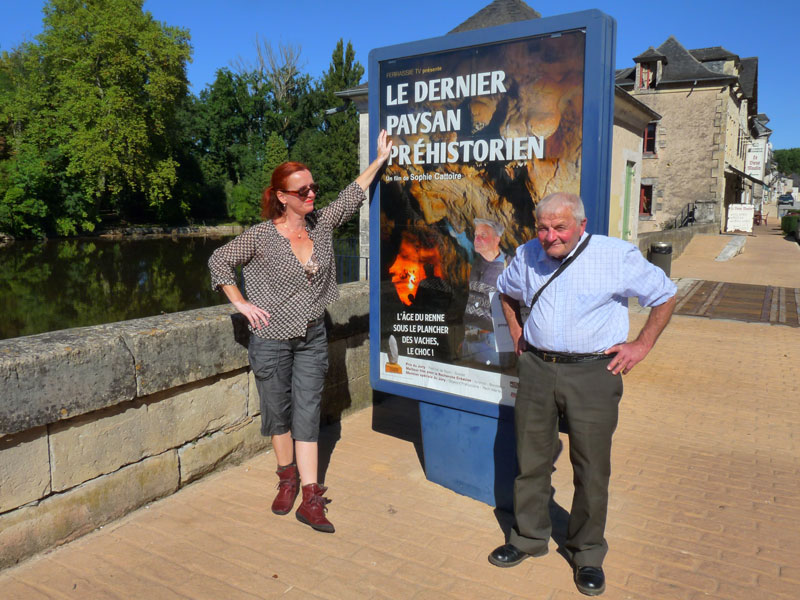
The music for the film
THE LAST FARMER-CUM-PREHISTORIAN
A film by Sophie Cattoire

The music of the film “The Last Farmer-cum-Prehistorian” (Le Dernier Paysan Préhistorien)
is a traditional mazurka I used to hear at the local peasants’
village dances when I was a child, with everyone enjoying dancing and laughing,
regardless of age. It is interpreted in acoustics in different carefully nuanced
ways by the LÉZAMIDAL
band from Alles-sur-Dordogne:
- Paul Deltheil: flutes, “cabrette” (Auvergne-style bagpipes) and diatonic clarinet
- Bruno Fontaine: transverse flute and quena (Andes traditional flute)
- Richard Bonnefoy: guitar and ukulele
- François Moreau: diatonic accordion
- Michel Paillé: tambourine,
and by
- Jean Bourlier: chromatic accordion
- Vincent Lesbros: transverse flute and piano
- Louise Flageul-Cattoire: piano
- et Oliver Le Solleu: acoustic guitar.
It’s important to emphasize that the theme music of the film was composed by Vincent
Lesbros,
thanks to the Cyclonium software programme he himself entirely developed.
He is a Doctor in Artificial Intelligence and his research focuses on how to use
images as music scores.
In short, he converts the artist-painter's gesture into an amazing musical
universe which could not be played by any existing instrument.
Composition of the original soundtrack of the film
TOUCH STONES (UN CHÂTEAU HANTÉ PAR LA PRÉHISTOIRE)
A film by Sophie Cattoire
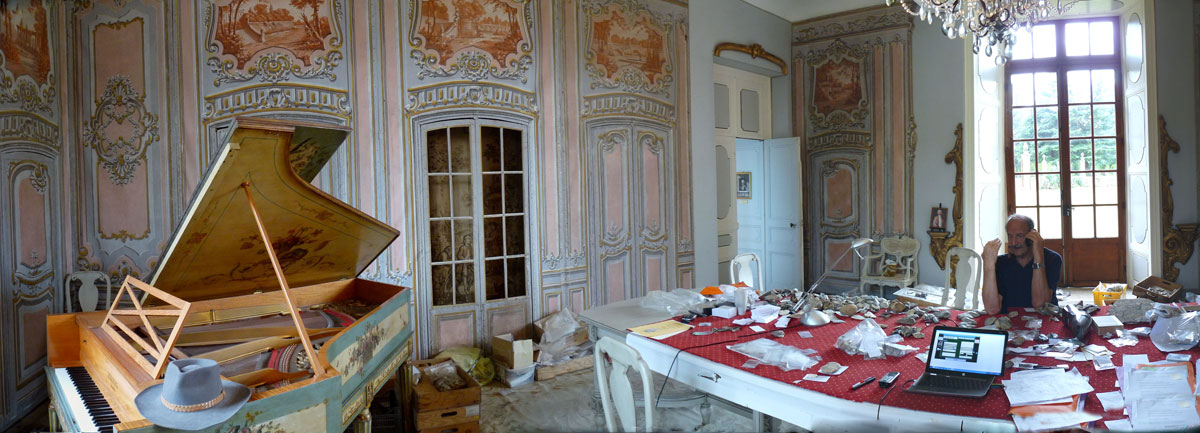
The original soundtrack of the film “Touch Stones” was in part improvised by Vincent
Lesbros,
echoing and conjuring up the atmosphere of the place, on the Pleyel piano at the
Château and his transverse
flute which he sometimes plays at the same time, playing the piano with his right
hand and the flute with his left hand.
The other part of the original music was composed thanks to the Cyclonium software,
adding a touch of poetic strangeness
emanating from the imaginary journey of a prehistoric man into the world of today.
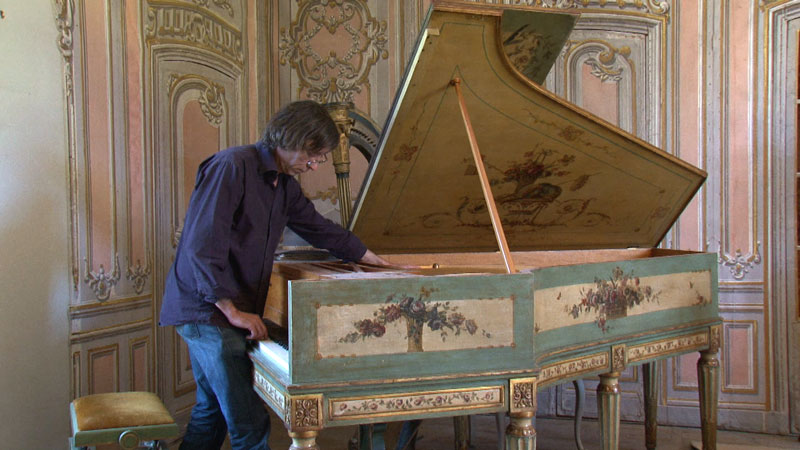
In this Grand Siècle Château the revenant is naturally familiar with the tools of
his peers:
bifaces, scrapers, flint blades, but he is also bedazzled by the 17th
century furnishings
stamped with the Louis XIV style, typical of Sauveboeuf Château in Aubas.
Furthermore, he is confronted with something extremely rare – at least for the age
he lived in,
the age of the mammoths – a Buffon-style cabinet of curiosities full of stuffed
animals.
Did they use to stuff bears in Prehistoric times?
The soundtrack draws its inspiration from this culture shock to create
a climate
shrouded in mystery,
at times full of fear, ultimately bringing out the sense of brotherhood down through
the ages,
understood by the inquisitive and erudite minds of Claude Douce, the lord of the
manor,
and his friend Jean-Luc Piel-Desruisseaux, an eminent expert on prehistoric tools.
Together, for 20 years, they have been collecting and classifying the finds of the
first prehistorians.
Crates full of “stones” have thus become the founding collections of the most recent
science: Prehistory,
the science that has been exploring our far-distant past for 150 years.
It should be noted that the videos in the opening and closing sequences of this
film were composed by two young Italians,
Giovanni Paolo Liotta and Andrea Castorina. They evoke the evolution of species
down through the ages and provide a fine
example of sounds produced by images, since these two composers used the ancestor
of Cyclonium: Sonographe, the software
program created by Vincent Lesbros
Composition of the original sound track for the film
THE BIRTH OF PREHISTORY
a film by Sophie Cattoire
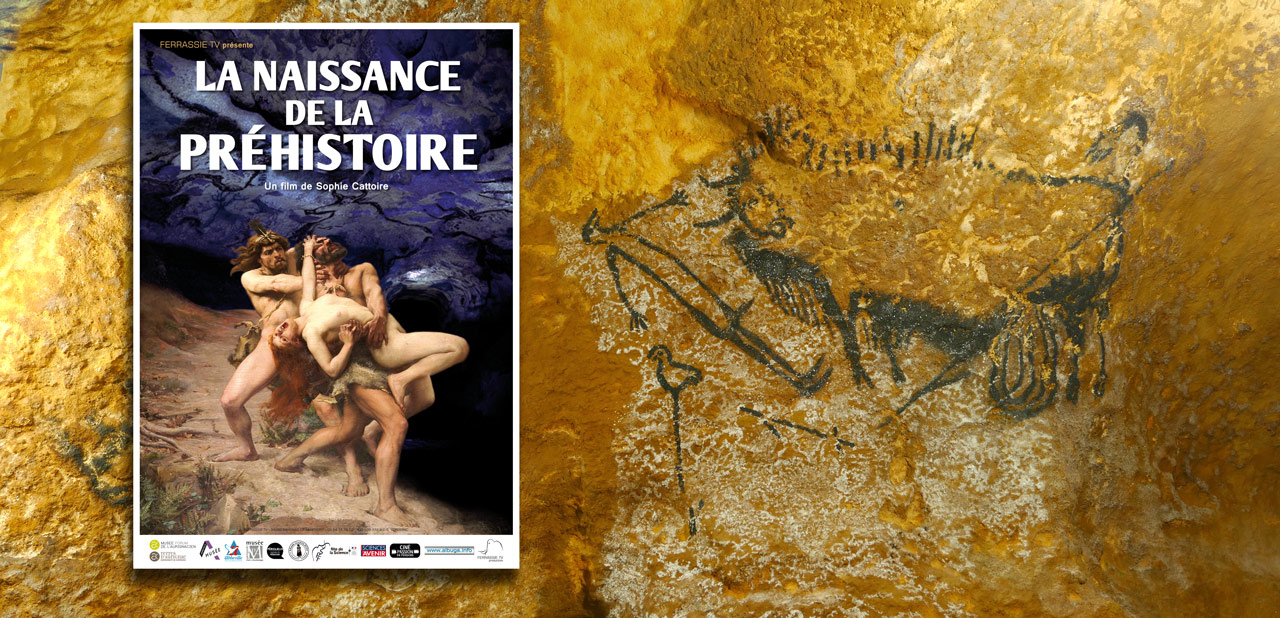
It was images that gave birth to Prehistory. It was images that generated the original
soundtrack of the film :
THE BIRTH OF PREHISTORY.
When watercolours become music scores, the whole spontaneity of the artist's gesture
transgresses the boundaries of time and space.
As for the original theme music of “The Birth of Prehistory”,
it was entirely composed using Cyclonium.
The challenge – both stimulating and captivating - was to create an ensemble
of pieces in the rebellious and innovative spirit of the 19th century
which,
reacting against Wagnerism, eventually saw the appearance of the group of
Six at the start of the 20th century: George Auric, Louis Durey, Darius
Milhaud, Francis Poulenc,
Germaine Taillefer and Arthur Honegger. All through the film,
we are taken on a Jules Verne-style journey back in time on the famous Pacific
231.
It must be remembered that Jules Verne was a disciple of Jacques Boucher de Perthes.
What’s more, the other important advantage with Cyclonium is that
this futuristic tool instils symphony orchestra instruments into the concert, sounds
coming from no natural vibration.
Synthetic sounds generated through purely virtual entities.
A means of making us understand the revolutionary aspect of the discovery of Prehistory,
a discipline that is anything but a thing of the past, because 150 years ago it
opened up the doors of time, freeing mankind from the shackles of the Bible in which
it had submissively imprisoned itself for 6,000 years by putting its trust in the
calculations of the Church and the scholars.
If you talk about God’s creation, a date needs specifying - a date before which
there was nothing but nothingness. This nothingness may have been 6,000 or 6 billion
years ago, but, when all comes to all, it all comes down to the same thing: what
was there the day before?
In short, like in a Sherlock Holmes police enquiry, we get swept along by this fascinating
soundtrack which,
at the same time, opens our minds to the liberating idea of infinity.
To describe the Cyclonium whirlwind which revolutionizes the way in which music
is composed,
see the video and article below.
This scientific contribution was presented at the opening of the
International Workshop on Smalltalk Technologies in Prague in August 2016.

Original music score for the film
NEANDERTHAL – THE RETURN (NÉANDERTAL - LE RETOUR)
A film by Sophie Cattoire

In the film “Neanderthal, the Return”, the music score, entitled “Intérieur
Extérieur”, is the work of Caroline Boë who composes and sings with the grace and impetuosity of a bird
enchanting nature. In this piece, with her classical singer voice, she echoes The
Song of the World, regaling us with a delicate and compelling opera-style chant
This contact with nature, enhanced by her acute sensibility, fits in perfectly with
the atmosphere of the film which affirms the rehabilitation of Neanderthal man,
not as a rough and deformed individual, but well and truly as an ancestor of ours,
clever, feisty and fully in tune with the world around him.
|
CYCLONIUM: A software for composing. A creation by Vincent Lesbros, PhD in Artificial
Intelligence, to be discovered on this video.
|
|
Excerpt from Chromatic and Harmonic Scales for Intuitive Sonographic Compositions
By Vincent Lesbros
GAIV - FERRASSIE-TV
IWST'16, August 23 - 24, 2016, Prague, Czech Republic
Abstract
Historically, sonographic representations of sounds are based on two types of scales:
linear or logarithmic (Xenakis, 1971; Roads, 1995; Lesbros, 1995, 1996; Xiaoying,
2008). These two kinds of scales introduce
beats between sounds produced by adjacent lines of the image. In a linear scale,
for example, of 1 Hz by pixel, a beat of 1 Hz will appear if any horizontal line
has a thickness of more than 1 pixel. In a logarithmic scale, for example, of 192
ppo (pixel per octave), a beat of one 16th of semitone will spread. Here, we introduce
a new kind of scale in order to use hand drawn sonographs, avoiding this particular
beat effect. We extend the usual additive method to frequency modulation and add
a way to spacialize sonographs in stereo channels. We propose different kinds of
filters to control rhythm and harmony, and finally, we expose a way to compose music
tightly linked with a video by creating sonographs directly from video frames.
Introduction
If music and painting pull at your heartstrings, you may like to create a correspondence
between the two, turning a simple brush stroke into a flight of lyricism, letting
colour set the tone and the power behind the brush bring new vivacity to a piece
of music.
While so doing, you will want to know all the ins and outs, understand the underlying
physical structure, the theory of light (QED: The Strange Theory of Light and Matter;
Richard Feynman, 1985) and the fundamentals of sound synthesis. UPIC (Unité Polyagogique
Informatique du CEMAMU), Phonogramme (Vincent
Lesbros 1991) and Sonographe (Vincent
Lesbros 2004) have paved the way. Cyclonium is the fruit of more advanced
research, aiming toward a faithful reproduction of spontaneity and in-depth understanding.
This article focuses on three points developed in our new framework Cyclonium: frequency
scales with regard to timbre, the geometry of rhythm associated with mathematical
series and potential cohesion between musical composition and the temporal progression
of animated images, such as those in videos or in films.
The standard use of Sonographe consists in the design of a two dimensional image,
structured from left to right in time, and from bottom to top for the bass frequencies
up to the treble ones. The image is thus translated into sound by a logical computer
process: a formula in line with physics, taking place in a discrete world, where
the real numbers are reduced to artificial and incomplete representations.
|
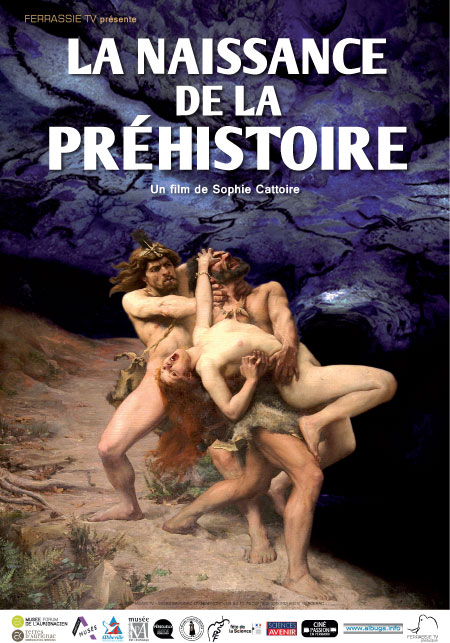
|
|
THE BIRTH OF PREHISTORY
|
Pour organiser une projection,
nous contacter : Sophie Cattoire
FERRASSIE TV
La Ferrassie
24260 Savignac de Miremont
Tel : 09 64 11 78 52
Port: 06 22 97 69 85
mail : allezzou@wanadoo.fr
|
|
|
|
The game consists in transmitting, in the best possible way, the author’s creative
energy during the rendering of the final result, by transforming the initial trace
left on paper into speaker vibration.
The choice of language is paramount in what it is possible to express (1996, Claude
Hagège, L’homme de parole). « Composer c’est programmer, programmer c’est composer »
wrote Giuseppe Englert. (Giuseppe G. Englert, 1989).
Cyclonium builds a bridge between the efficiency of the C language and the flexibility
of Smalltalk with a constant concern to help visualize the manipulated elements
and processes of transformations and calculations. The latest version automatically
generates the C code and the interface for the programs expressed by the user in
the Smalltalk environment by drawing graphical schemes.
By composing a piece of music on paper with a brush, you will be able to obtain
a comprehensive, heuristic and intuitive vision, with no holds barred as to your
creative gesture. Translating the strokes, the colors and the textures, takes you
closer to the physical structure of the image and sound. If you do not actually
reach their physical structures, their IT ersatz is at least created.
Cyclonium offers a discrete space-time at the level of the sample in the sound domain
and at pixel level in the graphical field, as well as special tools for linking
visual and sound aspects, opening the door to any new creative metaphor significant
in these spaces. Images can thus be translated into sounds through the programming
activity. Moreover, it is also a way of creating first-hand what moves us, namely
images and sounds.
In conclusion, a simple rule in the programming space can give rise to complex phenomena,
usable in the artistic effervescence, and yet to be described. Cyclonium is an exploratory
tool to reveal these phenomena, raw material for creation.
Full text
Chromatic and Harmonic
Scales for Intuitive Sonographic Compositions
Sound samples
Sound samples on SoundCloud
|
Find out all about our films on:

|
|
|



